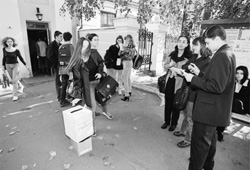New Generation Makes Choice

Presidential elections are drawing near with seven-mile strides. Last Tuesday, the Youth Committee of Ukrainian Electors carried out an interesting action, so-called student presidential elections (see photo). Students of over 200 Ukrainian higher educational institutions were given the chance to fill out 500,000 ballots including all the presidential candidates. The right side of each ballot was an identical copy of the official ballots which most of us (hopefully) will see on October 31; the other side featured an appeal to vote and make the right choice, along with a brief description of the voting procedure in order to “enhance the public activity of the youth”.
The students cast their votes as follows: 31.73% for Leonid Kuchma, 12.57% for Natalia Vitrenko, 9.55% for Yevhen Marchuk, 7.37% for Oleksandr Moroz, 3.55% for V. Kostenko, and 4.06% for Petro Symonenko.
It is worth noting that, according to television coverage of results in Kyiv the day before, Mr. Marchuk came in second. Incidentally, election organizers complained that, when they were counting up the votes, they were receiving phone calls from almost all Cabinet of Ministers and Presidential Administration officials who wanted to know the results or even demanded doctoring them. Members of the Student Central Electoral Commission (SCEC) noted that one could only imagine the degree of pressure to be applied to commission workers during the “adult” elections. Ms. Vitrenko's second place is not unusual, with due account of the fact that it is the Kaniv Four that has presented the greatest danger for Mr. Kuchma since it was formed. The current President's team needs a backup for Mr. Symonenko who seems to have failed to play the role of red peril.
Nevertheless, commenting on the results forecast by The Day , SCEC members explained Ms. Vitrenko's popularity by the fact that the bold radicalism of the only female presidential candidate appeals to students who have lost their own revolutionary spirit. (It would be interesting to look at a normal future higher educated specialist to whom Ms. Vitrenko's bold spirit of uranium mines appeals.) A more correct comment on Ms. Vitrenko's “success” (if it really was) might lie in the fact that the degree of societal lumpenization as a result of our illusory reforms is already crossing the line of social pathology.
The SCEC puts down Mr. Kuchma's victory only to the President's recent decree to increase student stipends. However, the students could not have been bought (judging by the results of this action) for a few hryvnias if the central media had not been actively hyping the image of the big-hearted and omnipotent Uncle President. Regional students, as the organizers claim, had heard practically nothing about other contenders for the top spot. SCEC legal adviser Yevhen Radchenko said at a press conference that the young people's presidential election is nothing but a sociological survey. So a second round is out of the question. If so, the correctness of the survey can be challenged. For most ballots were sent to Dnipropetrovsk oblast: 50,000, which is, e.g., five times as many as to the Crimea, Donetsk and Zhytomyr oblasts, and over 100 times as many as to Kirovohrad oblast. (In other words, the number of ballots in the regions was not proportional to the number of students in them. Sociologists would call this a gross sampling error.) About a hundred institutions of higher learning dropped put of the organizers' field of vision. Moreover, only each fifth student voted, out of the 500,000 who received ballots. For whom will the 80% who did not wish to show their preferences vote? Also for Mr. Kuchma? For the victorious “already-traditional popularity” of the President have not yet been expressed in sentiments: you cannot see any mass outbursts or crowds of voters desiring to see Mr. Kuchma get another term as President.
Newspaper output №: Section






